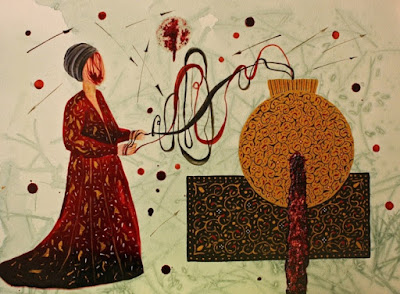The other day, I walked into the Lilly Library
hoping to find a book on an artist whose works would catch my interest. I decided that
I wanted to find a book on an artist who I had never heard of before, and I
decided that I would not be picky. As I sat down to starting searching for
books on the catalogue, I found myself trying to find an artist of Iranian
identity—an aspect of my character that I
greatly value—who emulated the culture into their
work. When I could not find much on the library catalogue, I decided to just
walk around and try to find something else that would peak my interest by perusing the stacks. Still,
I found myself walking through the stacks trying to find the section on Iranian
artwork that I kept hoping existed. I found a couple of books that were not
related to Iranian culture and art just in case I could not find something else.
Finally, towards the end of the art stacks, I found the tiny Iranian artwork
section, and I came across one book highlighting the works of the Tehran-born
artist Shiva Ahmadi.
Shiva Ahmadi’s life began in 1975, just four years before the Iranian
Islamic Revolution. Her adolescence spanned the Iran-Iraq war from 1980 to 1988.
Her life was placed in the context of tumultuous and unstable political times,
and her life has been greatly influenced by these experiences (Grigor 39-43). She
went to Azad University in Tehran where she studied abstract painting, and
began to incorporate these political influences into her work when exploring
the art of Persian miniature paintings during her Masters education in painting
that she continued in the United States (Yun 77-79).
 |
| Fig. 2. Untitled 2, 2016. Watercolor and Ink on Paper. |
Ahmadi is mostly a watercolor artist who paints detailed and elaborate paintings that are inspired by the traditional art of Persian miniature paintings. At first glance, these paintings are beautiful and colorful with the use of varying lines that resemble Persian calligraphy. Even with her use of watercolor, she is able to retain the beautiful detail that resembles the patterns of Persian rugs. When further processing her art, one may begin to realize a darkness with splashes of blood and common symbols of power and corruption. Across her artwork, one may notice the common use of tied animals, bombs, grenades, and thrones that may are indicative of the tension and corruption that existed in the Middle East at the time and continues to exist throughout time (Yun 77-79). Her paintings commonly depict a central character with a face bloodied with calligraphy who sits on a throne holding a bomb (Grigor 39-43). Her splatters of red painting that drip from the bottom of the throne represents a dark position of power.
 |
| Fig. 3. Lotus, 2013. Watercolor, ink, and acrylic on Aquaboard. |
The artists use of negative space as one of a tan to beige color reminds me of the use of lamb or other animal hides as a canvas for paintings, a common traditional practice of the region. She commonly places the powerful figures of her artwork in the upper and central portion of her artworks. From that central focal point, the observer’s eye pans across the entire painting, full of chaotic figures that are all seemingly in a state of despair and lesser status (Grigor 39-43). Her use of watercolor creates a soft flow that is interjected by detailed lines and designs that create tension and structure in the context of smoothness. Most commonly, the remainder of the figures are tied by ropes in the form of resemblance to Persian calligraphy by use of wispy strokes of her paintbrush.
 |
| Fig. 4. Golden Ball, 2015. Mixed Media on Aquaboard. |
While her work is haunting, you cannot help but appreciate her take on this beautiful tradition as her medium of expression.
References
Grigor, Talinn. "The Violence of the Armchair." Shiva Ahmadi. Skira, 2017, 39-43.
Yun, Michelle. "Shiva Ahmadi: Witness." Shiva Ahmadi. Skira, 2017, 77-79.
"Shiva Ahmadi." Leila Heller Gallery, 2017, http://www.leilahellergallery.com/artists/shiva-ahmadi.

No comments:
Post a Comment